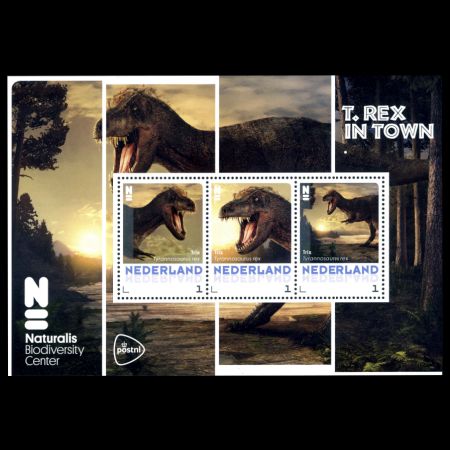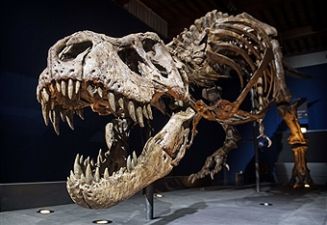Netherlands 2016 "T. rex in town"
| <prev | back to index | next> |
| Issue Date | 10.09.2016 |
| ID | Michel: N/A, Scott: N/A, Stanley Gibbons: N/A, Yvert et Tellier: N/A, Category: pR |
| Design | |
| Stamps in set | 3 |
| Value | '1' rate stamps
(domestic letter rate, €0.73
at time of issue) x3 Tyrannosaurus |
| Size (width x height) | stamps: 30 mm x 40 mm, Mini-Sheet: 145 mm x 100 mm |
| Layout | Mini-Sheet of 3 stamps |
| Products | Postcard x1 (3 identical postcards sold in a set with the Mini-Sheet) |
| Paper | |
| Perforation | Offset lithography, multicolor |
| Print Technique | |
| Printed by | |
| Quantity | |
| Issuing Authority | Naturalis Museum |

On September 10th, 2016, the Natural History Museum "Naturalis Biodiversity Centre" (Leiden, the Netherlands) in cooperation with the Netherland's Post, issued the Mini-Sheet with three personalized stamps to commemorate "T. rex in town" event that took place between September 10, 2016 and June 2017.
Although issued by the Netherland's Post, they were only available through their collectors shops at more than twice their face value.
The Logo of the museum was depicted on the bottom-left corner of the Mini-Sheet.All stamps shows reconstructions of the Tyrannosaurus rex, named "Trix" in honor of former queen Beatrix.
This is the first complete Tyrannosaurus rex skeleton mounted in a Museum in the Netherlands. At the time of these stamps issue it was the first and only Tyrannosaurus rex permanently on exhibit outside of North America.
The story of this Tyrannosaurus began in the summer of 2012 when the museum's director, Edwin van Huis, expressed his ambition to get a Tyrannosaurus. Researchers from the Naturalis went on an expedition in the United States, where almost a year later fossils of Tyrannosaurus were unearthed from the sandstone in Montana. With the help of crowd funding, the Naturalis Biodiversity Centre, succeeded in excavating and buying this unique prehistoric treasure at a cost of EUR 5 million.
 |
 |
| Tyrannosaurus Trix departing from Chicago’s O’Hare International Airport Image credit: Blog of KLM | Passport Tyrannosaurus Trix. Image credit: Daily Mail |
At an earlier press conference, a group of representatives from the Netherlands and the US unveiled a large Dutch passport for the dinosaur. Trix officially arrived in Leiden a few days later and was welcomed to town with a celebration featuring hundreds of local school children. A caravan that included a marching band, a T. rex parade float, TV naturalist Freek Vonk, and paleontologist Anne Schulp led a lorry carrying the bones to a stage set up in the city’s historic Beestenmarkt.
During its lifetime, the dinosaur would have stood 4 – 5 meters tall and weighed 5.000 kilogrammes. The skeleton measures 12.5 meters from nose to tail and four meters at the hip. According to analysis by the Naturalis staff, the dinosaur was likely a female and would have died at about the age of 30 around 66 – 67 million years ago.
The skeleton is 80% complete and consists of consists of 300 bones, 55 of which make up the huge skull and it is one of the most complete skeletons of Tyrannosaurus found to the date of these stamps issue. The missing bones were reproduced by 3D printing and were painted a slightly different colour so that visitor of the museum can see what parts of the skeleton was missing.
Anne Schulp, head of Tyrannosaurus rex research at Naturalis said:
For a museum it’s almost an advantage when you’re missing bones because in a 3D print you can easily add a hole in the middle and run steel through the inside of the print. So what we often do if we have one leg but not the other is that we take the steel frame that supports the entire dinosaur and hide it inside the lightweight 3D printed replica bones to support the rest of the entire skeleton.
Trix was mounted in a unique pose, low to the ground. This pose was designed to make her seem more dangerous and intense than other mounted T. rex skeletons in other museums around the world. This pose allows visitors to see into the eyes of this dangerous prehistoric predator. The pose was chosen because Trix features her actual skull instead of a replica. The skull required a substantial amount of support that could not be accommodated with the more traditional poses for T. rex in museums.
 |
 |
 |
| Mounted skeleton of Trix Tyrannosaurus on display in the Naturalis museum. Image credit: Volksstimme | Skeleton of Trix Tyrannosaurus being reconstructed. Image credit: Businesswire, | |
Products and associated philatelic items
| Postcard | Example of Circulated Cover | |
 |
 |
|
| Examples of Circulated Postcards | ||
 |
 |
 |

|
References
- Technical details and stamps presentation:
Stampedout colnect - Naturalis Biodiversity Center:
official website, - Tyrannosaurus Trix:
Wikipedia.-
Trix transportation:
Daily Mail, Dutch News, Businesswire,
-
Trix transportation:
-
Other websites who have removed their articles related to Trix discovery and transportation:
Cargo forwarder, Lonely Planet , Blog of KLM, Notey Lab.
Acknowledgement:
- Many thanks to Dr. Peter Voice from Department of Geological and Environmental Sciences, Western Michigan University, for reviewing the draft page and his very valuable comments.
| <prev | back to index | next> |